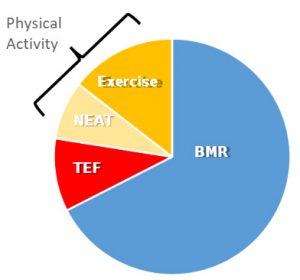TDEE stands for Total Daily Energy Expenditure, that is the total amount of energy in calories an individual burn per day.
In general terms, a healthy weight loss should aim at 2 pounds every week. In most cases, that would be achieved with a calorie deficit of 500 kcal, but every individual behaves differently, and in some cases, you will need to make further adjustments to meet a constant weight loss of 2 pounds a week.
Your weight loss results from your calorie intake vs. your calorie output, and many aspects of your daily life, hormones, and habits interacts to modulate your balance of calories.
The reason why you’re not losing weight might be related to any of these factors, and since everyone is different, you should continuously adjust your diet and physical activity to obtain good results.
There are also medical problems associated with not being able to lose weight, and they should be assessed by a doctor.
Losing weight is achieved through a calorie deficit, and it is possible to obtain good results with diet alone.
However, physical exercise increases your lean mass and your basal metabolic rate, and it is a source of extra burnt calories that will speed up your weight loss goals.
Use this calorie deficit calculator

Your body can naturally produce around 2 pounds of muscle mass every week, so 500 extra calories are fine if you want to bulk with a minimal fat gain.
Keep in mind that eating the right proportion of proteins and healthy fats are essential to achieve these goals.
If you change your level of physical activity, your job, or have a change in body weight of 10% or higher, it is recommended to recalculate your TDEE. Otherwise, it will not be necessary.
Accuracy in calculating TDEE depends on the TDEE formula and yourself. Entering accurate data instead of estimates will make your results more reliable.
The equations for calorie estimation give you a margin of error of 10% above or below, which is why they should be further adjusted according to your results.
For most people, it is accurate, and it is an excellent way to aim for a healthy weight. However, you don’t need to achieve the exact number of your ideal weight to be healthy.
Instead, aim at maintaining your body fat somewhere between 10 and 15% and keep a healthy muscle mass, which in most cases will place you very near your ideal weight.
You can do this according to how many days you go out and do some exercise.
Sedentary individuals do not exercise at all, light exercise is achieved after 1-2 workouts a week, moderate exercise is 3-5 workouts a week, and if you exercise 6-7 times a week, choose heavy exercise.
These workout sessions are real workouts that make you sweat, and keep in mind that certain jobs may be physical enough to account as exercise.
BMI formula is based on your height and weight but does not take in consideration your body fat percentage and lean mass.
Some people with a lot of muscle mass might get a very high BMI, and this formula does not apply in these cases.
Your macronutrient ratio depends on your goals. In general terms, carbohydrates will take 45 to 65% of your diet, the protein will take 10 to 35%, and fat will be around 20 to 30%. Use this Macronutrient Calculator for detailed break down.
However, in weight-loss diets, no more than 50% carbs are recommended, and if you’re physically active, you might benefit from 25 or 30% of protein.
Fats should be increased to 30% if you’re trying to bulk and 20% if you’re trying to lose weight.